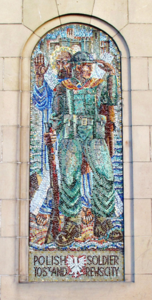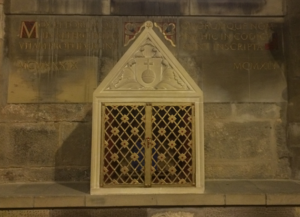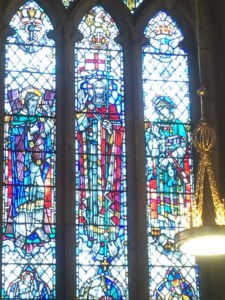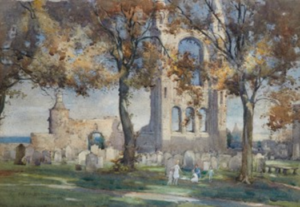‘St Andrews and the Second World War’
Greetings,
Today marks the 75th Anniversary of VE Day (Victory in Europe Day), the close of the Second World War in Europe. (The war continued in the Pacific.) The usual May Day holiday in the UK has been changed to today, and the University has followed suit in keeping with the commemoration. On VE Day in St Andrews 75 years ago today the news was ‘celebrated with restraint and dignity as well as with general rejoicings’, and the Town Hall was full for a ‘Victory Dance’.
The town of St Andrews itself was relatively unscathed by the war. A bombing raid on 25 October 1940 damaged the University’s Bute Building amongst others when bombs landed around St Mary’s Quad. As Norman Reid writes in Ever to Excel: An Illustrated History of the University of St Andrews, “hundreds of fragments of glass had to be removed from the bindings of library books.” The only fatal bombing took place on the night of 5 August 1942, destroying a house on Nelson Street. It was reported that 14 people were killed by the raid.
St Andreans served in many ways. There are a handful of memorials in the town to the Second World War. The War Memorial by the Cathedral lists the service personnel who were killed; there are 20 Commonwealth war graves in the Western Cemetery; the Victory Memorial Hall, as it says on a plaque inside, was formally constituted in 1960 as a memorial to those servicemen who lost their lives in the 1914-18 and 1939-45 war. There are also memorials to the many exiled Polish soldiers in east Fife including General Sikorski. Indeed, many Polish soldiers enrolled as students in St Andrews. This striking mosaic on the Town Hall featuring a Polish soldier with St Andrew behind offering support was created by three Poles, unveiled during the war in 1941.

How has the Second World War been remembered in the University?
Students and staff lost their lives in the war, of course. Their names are written in the Roll of Honour which is housed in a stone tabernacle in St Salvator’s Chapel, designed by Reginald Fairlie, carved with the St Salvator’s College arms:

Above is the Second World War Memorial Window, by William Wilson, unveiled by the late Queen Elizabeth, the Queen Mother, in 1950. In the centre light is the figure of St Salvator – Christ bearing the wounds of the crucifixion and the banner of the resurrection. To the left stands St Andrew with his fishing nets and cross, while in the right-hand light is St Leonard with his broken chains. Above these three figures are the badges of the Royal Navy, British Army and Royal Air Force.

The University also holds the Pilgrim Trust Recording Scotland Collection of artworks. The Recording Scotland project was launched in 1942, designed to produce employment for artists during the Second World War, and create a permanent pictorial record of a Scotland thought to be at risk from bombs and growing industrialisation. The collection was presented to the University of St Andrews in 1952 in tribute to Sir James Irvine, University Principal, who was the Chairman of the Recording Scotland Committee. Principal Irvine’s own son was drowned on naval service in 1944. Among the collection is this autumnal view of the Cathedral by Alexander Nisbet Paterson.

University of St Andrews Museum Collections, HC84
Metaphors of war and battle are common at present in the Covid-19 pandemic. Opinions vary as to the suitability of using such language. Those who have lived through a time of war may be more aware of the differences than any similarities. In recalling the end of this gruelling war in Europe, and the millions who died both in battle and as civilians, in bombing raids and in the death camps, perhaps we can find a sense of perspective for what faces humanity today.
On this holiday, let us be grateful that the war came to an end, that the loss of so many people ceased, that liberation came to many, and that, in much of Europe since, we have known peace.
Our coming Sunday service will focus on this celebration and commemoration, with a sermon from our Assistant Chaplain Revd Samantha Ferguson, whose home is Guernsey, occupied during the Second World War, and for whom today is Liberation Day. Here is the invitation:
Donald MacEwan is inviting you to a scheduled Zoom meeting.
Topic: University Worship for Sunday 10 May
Time: May 10, 2020 11:00 AM London
Join Zoom Meeting
https://zoom.us/j/97757355713?pwd=bkwybzlaVCtFZVBlSHFvQUVIVkVsUT09
Meeting ID: 977 5735 5713
Password: 0QriyP
Yours,
Donald.

Oh yea, I was exploring the subject for the while, and this particular post helped myself a lot. I am so happy to be able to find what We was looking regarding in this post. I’ve previously read the post in this article https://ideenkicker.ch/pathfinder-wrath-of-the-righteous/, but your own article is much deeper regarding the knowledge of the subject industry. Thank you for this ground research!
After reading this post Personally i think like a person are the best writer now. The post is actually a tremendously structured and well-thought one. It jogged my memory regarding https://www.sitejabber.com/reviews/essayservice.com. Appears like typically the author genuinely be familiar with case inside stage. This piece is usually indeed a very good read. So many interesting information I actually didn’t realize prior to. Thank an individual for a good function. Keep it upward in the future!